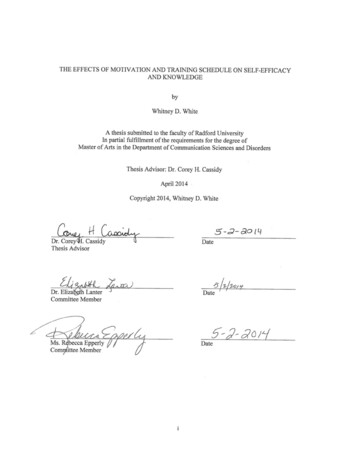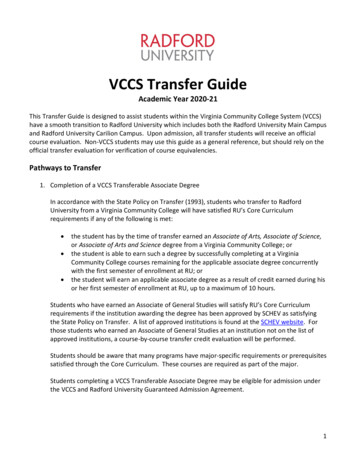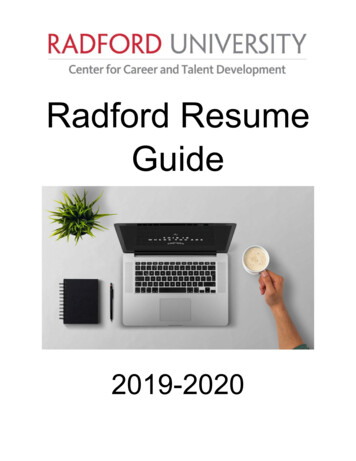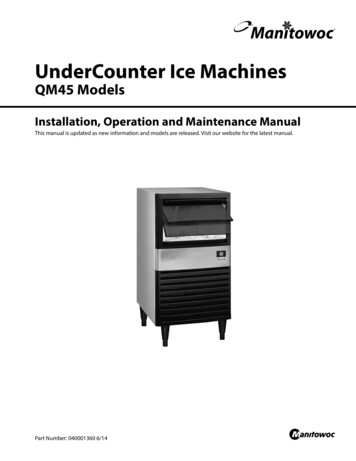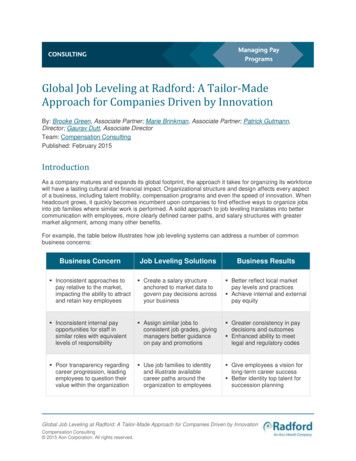
Transcription
Global Job Leveling at Radford: A Tailor-MadeApproach for Companies Driven by InnovationBy: Brooke Green, Associate Partner; Marie Brinkman, Associate Partner; Patrick Gutmann,Director; Gaurav Dutt, Associate DirectorTeam: Compensation ConsultingPublished: February 2015IntroductionAs a company matures and expands its global footprint, the approach it takes for organizing its workforcewill have a lasting cultural and financial impact. Organizational structure and design affects every aspectof a business, including talent mobility, compensation programs and even the speed of innovation. Whenheadcount grows, it quickly becomes incumbent upon companies to find effective ways to organize jobsinto job families where similar work is performed. A solid approach to job leveling translates into bettercommunication with employees, more clearly defined career paths, and salary structures with greatermarket alignment, among many other benefits.For example, the table below illustrates how job leveling systems can address a number of commonbusiness concerns:Business ConcernJob Leveling SolutionsBusiness Results Inconsistent approaches topay relative to the market,impacting the ability to attractand retain key employees Create a salary structureanchored to market data togovern pay decisions acrossyour business Better reflect local marketpay levels and practices Achieve internal and externalpay equity Inconsistent internal payopportunities for staff insimilar roles with equivalentlevels of responsibility Assign similar jobs toconsistent job grades, givingmanagers better guidanceon pay and promotions Greater consistency in paydecisions and outcomes Enhanced ability to meetlegal and regulatory codes Poor transparency regardingcareer progression, leadingemployees to question theirvalue within the organization Use job families to identityand illustrate availablecareer paths around theorganization to employees Give employees a vision forlong-term career success Better identity top talent forsuccession planningGlobal Job Leveling at Radford: A Tailor-Made Approach for Companies Driven by InnovationCompensation Consulting 2015 Aon Corporation. All rights reserved.
The business challenges outlined in the table above are certainly not unique to the technology and lifesciences sectors where a majority of Radford’s clients reside; however, these concerns are exacerbatedby high rates of growth and rapid demands to evolve business models and talent profiles to meetchanging market forces. For technology and life sciences companies, who live and die based on theirability to innovate, these types of challenges are significant and make it all the more important to employeffective job leveling systems.In light of this dynamic, over the past several years, our team has observed a steady shift away fromhighly regimented job leveling models at technology and life sciences companies, specifically point-valuebased systems. In Europe for example, a recent survey by our consulting practice indicates that 20% ofresponding companies revaluated or redesigned their job leveling architecture in the past year, andanother 30% of respondents are prioritizing updates in the year ahead.Increasingly, human resources and talent leaders at technology and life sciences companies seek jobleveling tools that have enough built-in flexibility to handle cultural differences, local and regionalregulations, diverse business needs and changing talent requirements. At Radford, our global levelingapproach, which is integrated into the global architecture of our surveys, meets these requirements.The Radford ApproachWhen we talk about job leveling at Radford, we’re describing a method of creating a structure that hasarticulated career paths for various job families and which can support a global organization. However,this system is underpinned by job architecture, which is a method of organizing jobs into job codes, jobtitles and functional areas all before assigning a grade level. The chart below illustrates the relationshipbetween job leveling and job architecture— both of which are critical to creating a solid foundation forcareer path mobility and highly effective salary structures.Global Job Leveling at Radford: A Tailor-Made Approach for Companies Driven by InnovationCompensation Consulting 2015 Aon Corporation. All rights reserved.
To take these models a step further, the following case study describes how we can translate thesometimes abstract concepts of job architecture and job leveling into successful systems at largemultinational companies:Case Study:A leading technology company headquartered in Europe with a global footprintBusiness ChallengeOur client was undergoing rapid growth and looking to scale its domestic business into moreinternational markets. Until this point, the client had different approaches to managingcompensation programs and job grading across its functional areas and business units. Thecompany needed to evaluate and compare its current leveling structures across the businessagainst each other; develop a single consistent approach to leveling jobs; assign grades across thebusiness; and develop a dual career ladder, as too much emphasis was being placed onmanagement hierarchy at the expense of the technical individual contributor career paths.SolutionsOur critical first step in addressing these issues was to use current and relevant benchmarking datato begin assigning an overall job classification architecture to the various job titles at the company.We also conducted detailed interviews with senior leaders to confirm our understanding of jobcontent, career progression criteria and global level differentiators. This allowed us to combine ourdraft classification architecture based on market data with specific feedback on corporate goals andculture. Next, we aligned all job roles in the proposed architecture into grade levels with salaryranges attached for each geography and functional grouping.Finally, we undertook an impact analysis to understand the cost implications of moving to a newglobal system targeted at various levels of market competiveness (e.g., the impact of setting pay toththth50 vs. 60 vs. 65 percentiles of the market). Once the new system was approved by HR andbusiness leaders, we put a robust communication process in place to train managers on using thenew system in addition to a messaging platform for announcing the new system to all employees.Client ResultsAt the end of our engagement, the company had the following tools in place: Tailored job leveling matrices to outline level differentiation and progression for employeesacross different functional groupings; A new salary structure that was deployed in different countries and linked to robust marketdata from the Radford Global Technology Survey; Leadership buy-in via a transparent process and easy-to-understand methodology; and A governance process to review and update the structure on a regular basis in line withchanging business demands.It’s important to remember that job leveling systems are helpful for many types of companies— frompublicly-traded multinationals like the example above, to small, private, local companies seeking a flexiblefoundation upon which to grow. Embedding a common language for job leveling and career mapping intothe culture of a company at an early age can have long lasting dividends.Global Job Leveling at Radford: A Tailor-Made Approach for Companies Driven by InnovationCompensation Consulting 2015 Aon Corporation. All rights reserved.
Finally, it’s imperative that any approach to job leveling include enough elasticity in the system so that itcan be tailored to meet the demands of different companies and different markets. In the next section ofthis paper, we describe how Radford’s approach can be customized for companies operating in Asia,Europe and the United States.AsiaCompanies with operations in Asia often prefer to include what we call “tweener grades” into their jobleveling model. These grades are intermediate steps within a global career level that have their ownspecific base salary or fixed compensation ranges. This allows for more frequent performance reviewsand pay adjustments. This type of approach is sometimes used in China and India, where the jump in payfrom one official job level to the next is steep, and the promotional velocity for lower-level employees istypically expected to be rapid.The chart below illustrates how tweener grades can be developed specifically for Asia within the contextof a larger global leveling system. (In this case, we show data for a Software Engineer Systems positionin India using Radford Global Technology Survey data published in October 2014.)Global Job Leveling at Radford: A Tailor-Made Approach for Companies Driven by InnovationCompensation Consulting 2015 Aon Corporation. All rights reserved.
In the chart above, Global Grade 5 is subdivided into two tweener grades, 5a and 5b, in order toaccommodate more frequent performance assessments. The overall fixed compensation range for GlobalGrade 5 remains the same, at 560,000 INR to 1,040,000 INR; however, additional pay ranges now existwithin this span. In this example, we used the midpoint of Global Grade 5, typically the market median, asthe maximum pay level for Grade 5a. The maximum pay level for Grade 5b is the same as the maximumpay level for Global Grade 5.In Asia, it is also important to evaluate pay levels for support functions very carefully to separate technicalpositions from administrative roles and skilled production jobs whose requirements and pay levels mayvary considerably. While administrative, technical and production roles can still be aligned into consistentglobal job levels, each of these support functions should have their own market-based pay ranges toreflect their specific values in the local market.We also need to be aware of key markets where management talent may be paid a premium over whatwe typically view as comparable individual contributor positions in a dual career ladder global structure.Where this is a factor, separate market-based pay ranges can be created for management and individualcontributor positions that still remain in the same global grade for purposes of internal pay equity andglobal consistency.EuropeAnalytical forms of job evaluation, such as the point-factor approach, continue to dominate the landscapein many European countries due to the current regulatory environment, which requires pay equitycompliance in collective labor agreements. However, European companies as a whole are starting tobecome less concerned with minute levels of precision in favor of approaches that facilitate more dynamicorganizations that have the capacity to adapt pay and talent practices to more readily meet marketdemands.Still, driving this type of change has hurdles, and HR leaders need to be aware of the many steps thatmight be involved in migrating to a global leveling model. Some European countries, such as Germanyand Austria, have a strongly regulated labor force. For example, in Germany there is a strong influencefrom employee representatives (often in the form of “Works Councils”) enforced by the“Mitbestimmungesetz,” which requires that half the seats of the supervisory board represent theworkforce. If a company wants to implement a new grading or leveling scheme, the Works Council mustapprove the changes and be involved in the process. While the representative body doesn’t have legalauthority over determining the size of salaries, it does have a voice in the overarching scheme thatunderpins compensation decisions.In general, we find that companies in Germany (and other similarly regulated markets) are attracted to theRadford approach because it is rational, transparent and equitable, while still differentiating for highperformers. This should provide a solid foundation for negotiations with your Works Council. The key is tostart the process in a transparent manner and to have a strong business case for why a global levelingmodel will support long-term growth and innovation everywhere that your company operates.Insights from recent client engagements suggest a shift in thinking is underway among both managementand employee leaders. As the results from Aon Hewitt’s 2014Trends in Global Engagement show, careerdevelopment is at the top of employee engagement goals for both employees and companies. Thismeans that job leveling approaches quickly need to evolve beyond simply serving as defensibleframeworks for pay equity. They need to also serve as backbones for career path development,international mobility and incentive plan design.Global Job Leveling at Radford: A Tailor-Made Approach for Companies Driven by InnovationCompensation Consulting 2015 Aon Corporation. All rights reserved.
United StatesAt technology and life sciences companies in the US, dual career ladders—where managers andindividual contributors progress up the ranks in similar organizational levels—is now an organizationalnorm. Employees who have technical or scientific skills are no longer required, or even encouraged, topursue management roles in an attempt to further their careers if that’s not their desired career path orthey lack managerial skills. Companies have recognized the value of keeping experts focused on whatthey do best—the work itself.Radford’s global leveling approach recognizes this organizational reality by aligning job levels with boththe internal value companies place on individual contributor positions relative to managerial positions, aswell as the value the market places on each type of job. The system combines individual contributors andmanagers into global grades where market pay suggests equivalence. Below is an example of howdifferent job families are graded and grouped into two tracks—one for management and one for individualcontributor.This type of dual career ladder was utilized during a recent client engagement for a US life sciencescompany with limited plans to expand overseas. The company had a large number of employees withPhDs and needed to ensure alignment between scientific, management and business career paths.Radford consultants successfully implemented a job leveling system that helped employees understandthe different career opportunities available to them within their function and across the company. It alsohelped alleviate the pressure for scientists to move into management roles as the only way to advance intheir careers. At the same time, the same model was employed by a rapidly growing private onlinegaming company with multiple large offices in the US and a few smaller satellite offices in Asia andEurope, demonstrating the flexibility of this model across different business types and different job types.Global Job Leveling at Radford: A Tailor-Made Approach for Companies Driven by InnovationCompensation Consulting 2015 Aon Corporation. All rights reserved.
An increasing number of companies in the US are also using global leveling systems as a way todetermine eligibility for all manner of compensation and benefits programs, not just for setting base salarylevels. Global levels can be used to determine a position’s bonus eligibility, bonus target and equity grantguidelines. While regional differences in pay levels exist, the global leveling system enables a company tobe consistent in its determination of program eligibility by considering the internal equity of the positions ina given grade and then letting market practices dictate actual compensation levels.ConclusionAround the world, more companies are turning to global job leveling systems as a replacement for theirlegacy methods of grouping similar jobs across various regions and business units—whether theycurrently use a points-value system, generic job descriptions or something else. Job leveling, whendesigned correctly, greatly simplifies how global workforces are organized and managed by introducing acommon grading language across all employees and functions, while still differentiating for performanceand specific market realities. Importantly, most companies that turn to job leveling find the approach to bemore transparent, fairer and easier to communicate to employees. This infrastructure is also easier tomaintain as a company continues to grow its workforce and geographic reach.Radford’s global sales, technology and life sciences surveys provide companies the basis for creating ajob architecture that provides a framework upon which job leveling systems are built. Further, ourconsulting teams, with offices worldwide, understand the nuances of each market a company mightoperate in and have the experience and knowledge necessary to customize approaches for the particularlocation and circumstances of each client.To learn more about Radford's executive compensation, broad-based compensation, compensationgovernance, and sales force effectiveness consulting services, please visit: radford.com/home/consulting/Global Job Leveling at Radford: A Tailor-Made Approach for Companies Driven by InnovationCompensation Consulting 2015 Aon Corporation. All rights reserved.
Contact Our TeamTo start a conversation with a member of Radford’s compensation consulting team, please contact one ofour associates below:Boston OfficeSan Francisco OfficeSan Jose OfficeTed Buyniski, Partner 1 (508) 628-1553tbuyniski@radford.comLinda Amuso, President Radford 1 (415) 486-7255lamuso@radford.comBrett Harsen, Partner 1 (408) 321-2547bharsen@radford.comRam Kumar, Director 1 (508) 628-1557rkumar@radford.comBrooke Green, Associate Partner 1 (415) 486-6911brooke.green@radford.comSouthern Calif. RegionEd Speidel, Partner 1 (508) 628-1552espeidel@radford.comKyle Holm, Associate Partner 1 (415) 486-7717kyle.g.holm@radford.comRob Surdel, Partner 1 (508) 628-1551rsurdel@radford.comDavid Knopping, Partner 1 (415) 486-7122dknopping@radford.comLondon OfficeRobert MillerPartner, Head of EMEA Region 44 20 7086 5044rmiller@radford.comGuy PritchardAssociate Partner, EMEA Consulting 44 20 7086 5093gpritchard@radford.comKen Wechsler, Director 1 (760) 633-0057ken.wechsler@radford.comGaurav DuttAssociate Director, EMEA 44 20 7086 5092gdutt@radford.comBrenda De SouzaAssociate Director, EMEA 44 20 7086 5094bdesouza@radford.comFrankfurt OfficeGina WellmakerAssociate Partner, EMEA Survey Operations 44 (0)20 7086 5097gwellmaker@radford.comAnton MarinovichDirector, EMEA Survey Sales 44 20 7086 5099anton.marinovich@radford.comPatrick GutmannDirector, DACH Region 49 69 29727 6244patrick.gutmann@radford.comAxel SchütteAssociate Director, Germany Lead 49 69 29727 6248axel.schuette@radford.comGlobal Job Leveling at Radford: A Tailor-Made Approach for Companies Driven by InnovationCompensation Consulting 2015 Aon Corporation. All rights reserved.
About RadfordRadford, an Aon Hewitt company, is the leading provider of compensation intelligence and consultingservices to the global technology and life sciences sectors. Our market-leading surveys, equity valuationexpertise and strategic consulting help Compensation Committees and human resources leaders addresstheir toughest challenge: attracting, engaging and retaining talent in innovation-based industries.Radford offers clients a comprehensive suite of solutions, integrating unmatched global data capabilitieswith high-powered analytics and deep consulting expertise to deliver market-leading guidance to morethan 2,600 organizations annually— from Fortune 100 companies to start-ups.Headquartered in San Jose, CA, Radford has professionals in Bangalore, Beijing, Boston, Brussels,Frankfurt, Hong Kong, London, Philadelphia, San Francisco, San Diego, Shanghai and Singapore. Tolearn more, please visit radford.com.Global Job Leveling at Radford: A Tailor-Made Approach for Companies Driven by InnovationCompensation Consulting 2015 Aon Corporation. All rights reserved.
A new salary structure that was deployed in different countries and linked to robust market data from the Radford Global Technology Survey; Leadership buy-in via a transparent process and easy-to-understand methodology; and A governance process to review and update the structure on a regular basis in line with changing business demands.

